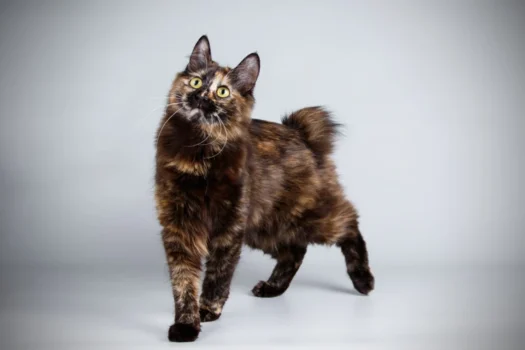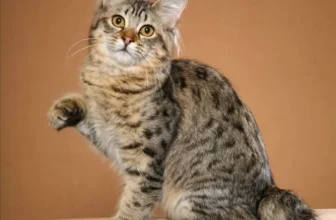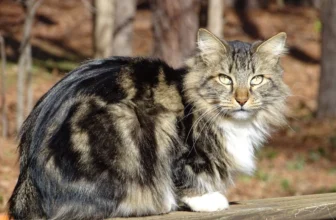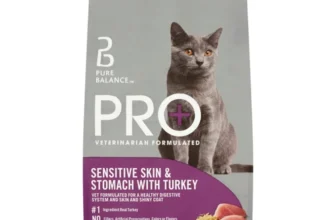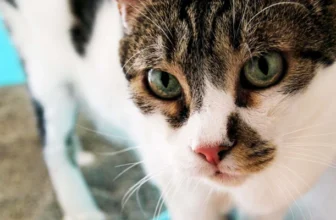Have you noticed that your American Bobtail cat seems to be gaining weight? Are you worried that your furry friend might be suffering from obesity? As a loving pet parent, it’s important to take note of your cat’s weight and body condition to ensure that they are healthy and happy. The effects of obesity in cats can be detrimental to their overall well-being, so it’s imperative to be aware of its signs and symptoms. In this article, we’ll delve deeper into what obesity is in cats, how to detect it in your American Bobtail cat, and what can be done to prevent and treat it. So let’s jump in and explore together!
What is Obesity in Cats?
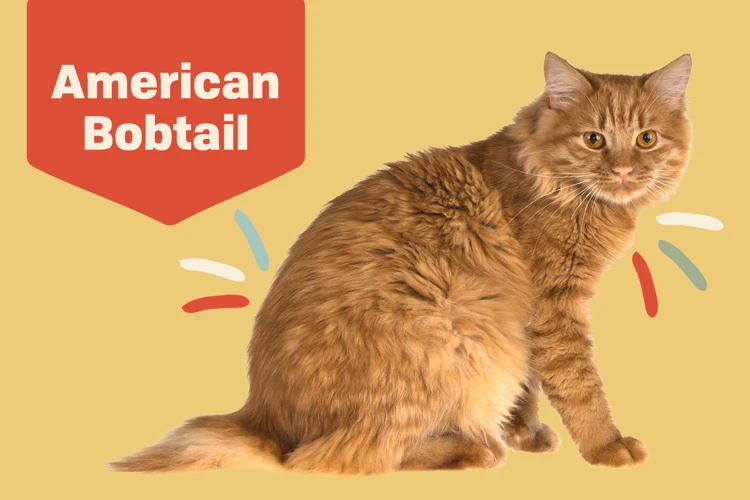
It’s no secret that maintaining a healthy weight is important for any cat. However, many pet parents don’t realize that feline obesity is a growing problem that can lead to a variety of health issues. In this section, we will take a closer look at what exactly obesity in cats is and what causes it. We will also discuss the signs and symptoms of obesity in American Bobtail cats so that you can recognize the problem before it’s too late. For more information, check out our article on obesity in American Bobtail cats.
Cat Obesity Causes
There are several causes of cat obesity that may affect the health of American Bobtail cats. These causes include:
- Overfeeding: Just like humans, if cats consume more calories than they are burning off, they will gain weight. It’s vital for pet parents to keep track of their cat’s calorie intake, especially if they are not very active.
- Lack of Exercise: Without regular physical activity, cats will not burn off the calories they consume. This can result in weight gain and can even lead to obesity.
- Neutering or Spaying: Fixed cats have lower energy levels than their intact counterparts, which means that they require fewer calories. Unless their food intake is adjusted accordingly, obese American Bobtails may result.
- Genetics: Some cats may be genetically predisposed to obesity, making it more challenging to maintain their weight. However, this does not mean that a healthy diet and exercise regimen shouldn’t be followed.
- Age: Older cats tend to have slower metabolisms and are less physically active, which can lead to weight gain if their diet is not adjusted accordingly.
It is important to be aware of the risks of obesity in cats and to take preventative measures to reduce the chances of obesity.
How to Tell if Your American Bobtail Cat is Obese
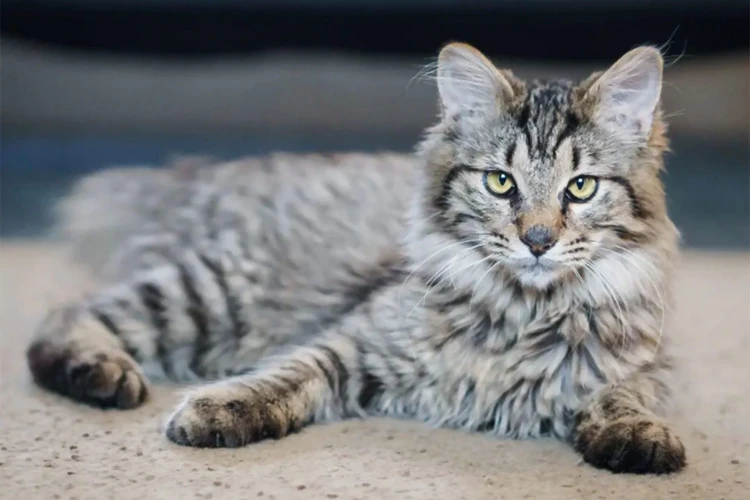
It can be difficult to determine whether your feline companion is at a healthy weight or not. But did you know that obesity is a common problem among American Bobtail cats? Understanding how to identify obesity in your cat is crucial to ensuring their wellbeing. By using a combination of various check-ups, you can determine whether your Bobtail is overweight or not. Let’s take a closer look at some techniques that you can use to spot the signs of obesity in your American Bobtail cat. For some tips on preventing or reducing obesity in your cat, check out our article on preventing obesity in American Bobtail cats.
Weight and Body Condition Score
Weight and Body Condition Score: One of the easiest ways to tell if your American Bobtail cat is overweight is to weigh them. You can do this by stepping on a scale while holding your cat and then subtracting your own weight from the total. However, this method isn’t always practical or accurate, since it’s difficult to get an accurate reading with a wriggling cat. A better method is to use a body condition score (BCS), which is a measure of your cat’s overall body fat.
There are several scales you can use to determine your cat’s BCS, but one of the most common is using a scale of 1-9. A score of 1 represents a very skinny cat, while a score of 9 represents a very obese cat. A healthy score is usually around 4-5, where you can feel your cat’s ribs without pressing hard but can’t see them. On the other hand, if you can’t feel your cat’s ribs at all and there is a noticeable layer of fat, your cat is overweight.
To determine your cat’s BCS, you’ll need to look for certain physical signs, such as the presence of a visible waistline, a sagging belly, and fat deposits on the lower back and base of the tail. You can also feel for excess fat over the ribs, spine, and hips.
It’s important to note that weight alone isn’t a reliable indicator of obesity in cats. It’s essential to look at your cat’s overall body condition, including muscle tone, bone structure, and body shape, to determine if they are at a healthy weight.
Regularly tracking your cat’s weight and BCS can help you identify changes that may point to the development of obesity. If you notice unexplained weight changes or find it difficult to keep your cat at a healthy weight, you may need to adjust their diet or get professional help from a vet.
For more information on how to prevent and treat obesity in American Bobtail cats, please refer to our previous article: “How to Reduce Obesity in American Bobtail Cats”.
Visual Cues
There are several visual cues that can help determine if your American Bobtail cat is overweight. Firstly, try feeling your cat’s ribs. If you are unable to feel the ribs, or they are difficult to palpate, it may indicate excess fat on the body. Additionally, look for a sagging or protruding belly, which is a common indicator of feline obesity.
Another visual cue is the presence of folds or fat pads around the cat’s back or tail. Obese cats often have thick, rounded pads of fat around these areas. A cat is considered to be overweight if it has a significantly smaller waist compared to the hips and chest.
It’s important to note that these visual cues should not be the only methods used to assess your cat’s weight. It’s always best to consult with a veterinarian to get a professional opinion. You can also refer to the vet checkup guide for obese Bobtail cats for more information about what signs to look out for.
If you notice any of these visual cues in your American Bobtail cat, it’s crucial to take the necessary steps to manage their weight. Adopting a healthier lifestyle for your pet can go a long way in preventing or reversing obesity. Check out some exercise tips for overweight Bobtail cats to help get your feline friend back on track.
Risks of Obesity in Cats
Carrying extra weight can be just as dangerous for cats as it is for humans. In fact, obesity is the most common nutritional disorder affecting pets worldwide. Here are some of the risks of obesity in cats:
| Health Risks | Description |
|---|---|
| Diabetes | Obese cats are at greater risk for developing type-2 diabetes. |
| Joint problems | The extra weight puts more pressure on joints and can lead to arthritis. |
| Heart disease | The heart has to work harder to pump blood to excess fat tissue, potentially leading to heart disease. |
| Respiratory issues | Excess weight can make it difficult for cats to breathe, which can result in respiratory issues. |
| Lowered immunity | Obese cats may have a weakened immune system, making them more susceptible to infections and diseases. |
| Shorter lifespan | Obese cats tend to have a shorter lifespan than cats of a healthy weight. |
It is important for owners to recognize the risks of obesity in cats and take steps to prevent it. This includes regular exercise and a healthy diet, as well as consulting with a vet for personalized advice. By taking action to prevent obesity, owners can help their American Bobtail cats live long and healthy lives.
Prevention and Treatment of Cat Obesity
When it comes to preventing and treating obesity in American Bobtail cats, there are a variety of approaches that pet owners can take. It’s never too early or too late to start implementing strategies to maintain a healthy weight for your furry friend. With the right combination of diet, exercise, and veterinary care, you can help your cat avoid the various health risks associated with carrying excess weight. In this section, we’ll discuss some of the most effective methods for preventing and treating cat obesity. So, keep reading to learn about some of the best ways to keep your American Bobtail cat healthy and happy.
Diet and Exercise
One of the most important steps in preventing and treating obesity in American Bobtail cats is to maintain a balanced diet and exercise routine. Obesity is often caused by overfeeding, so it is important to measure out the amount of food your cat is receiving. The amount of food needed depends on the age, weight, activity level, and breed of the cat.
A balanced diet for cats consists of high-protein and low-carbohydrate foods. Foods with high protein values, like chicken or fish, help cats feel full longer and provide necessary nutrients. Low-carbohydrate foods are also essential as cats do not have the necessary enzymes to break down carbs efficiently. Carbohydrates that are not digested can lead to weight gain and obesity.
It is also important to note that cat treats can add additional calories that lead to obesity. Limiting the number of treats given and choosing healthier options, like freeze-dried protein snacks or catnip, can help prevent weight gain.
Along with a balanced diet, regular exercise is crucial in maintaining a healthy weight for American Bobtail cats. Encouraging playtime and providing toys that encourage activity can help keep your cat moving. Engaging in interactive playtime with your cat, like using a laser pointer or chasing a string, can also provide necessary exercise.
A balanced diet and exercise routine not only helps prevent and treat obesity, but also leads to a healthy and happy cat.
Here’s a table to help you better understand the benefits of a balanced diet and exercise:
| Benefits of Diet and Exercise in Preventing Obesity in Cats |
|---|
| Reduced risk of weight-related health issues such as heart disease and diabetes |
| Better muscle tone and bone health |
| Increase in mental stimulation and overall happiness |
| Improved digestion and metabolism |
| Prevention of destructive behavior due to excess energy buildup |
Consulting with a Vet
When dealing with a potential case of obesity in your American Bobtail cat, one of the most crucial steps in proper prevention and treatment is consulting with a veterinarian. There are a myriad of reasons as to why a cat could be overweight and consulting with a vet can help to root out underlying health conditions that may be contributing to the issue.
During a consultation with a vet, it is important to be honest and forthcoming about your cat’s diet, exercise regimen, and behavior. Based on this information, the vet may conduct a physical exam and suggest further diagnostic tests to identify any underlying conditions contributing to your cat’s obesity.
Common diagnostic tests that may be recommended by a veterinarian include:
| Diagnostic Test | Purpose |
|---|---|
| Bloodwork | To identify any underlying health conditions, such as diabetes, liver disease, or thyroid dysfunction |
| Urinalysis | To identify any potential underlying health conditions, such as kidney disease or bladder infections |
| X-rays or ultrasounds | To assess your cat’s body composition and identify any potential underlying health conditions, such as heart disease or respiratory issues |
A vet can provide guidance on creating a weight loss plan for your cat, which may include dietary changes, increased exercise, and potential supplements.
Benefits of consulting with a veterinarian include:
- Identification of underlying health issues
- Creation of a personalized weight loss plan
- Expert guidance and advice on proper diet and exercise
- Monitoring of your cat’s progress and any necessary adjustments to the weight loss plan
Consulting with a veterinarian is a crucial step in addressing potential obesity in your American Bobtail cat. With their help and guidance, you can create a personalized weight loss plan and address any underlying health conditions contributing to the issue to ensure your cat is healthy and happy.
Conclusion
In conclusion, it is important to recognize the signs and symptoms of obesity in American Bobtail cats in order to prevent and treat this common health concern. By monitoring your cat’s weight and body condition score, as well as observing visual cues such as a round belly or difficulty moving and grooming, you can identify when your cat may be at risk for obesity.
There are a variety of causes of cat obesity, including overfeeding, lack of exercise, and underlying health conditions. It is important to consult with a veterinarian to rule out any health issues and to develop a personalized plan for diet and exercise.
Preventative measures such as feeding a balanced and appropriate diet, providing regular exercise and play, and monitoring your cat’s weight and overall health can help prevent obesity from occurring in the first place.
If your American Bobtail cat is already struggling with obesity, it is important to work with your veterinarian to develop a safe and effective treatment plan. This may include a gradual adjustment to a more appropriate diet, increased exercise and activity, and potential medical intervention.
Remember, every cat is unique and may require differing approaches to maintaining a healthy weight. By staying aware of the signs of obesity and working with your veterinarian, you can ensure your American Bobtail cat lives a healthy and happy life.
Frequently Asked Questions
What are some common causes of cat obesity?
Some common causes of cat obesity include overfeeding, lack of exercise, and genetics.
How do I know if my American Bobtail cat is obese?
You can tell if your cat is obese by checking their body condition score and looking for visual cues, such as a sagging belly and difficulty moving.
What health risks are associated with cat obesity?
Cat obesity can put your pet at risk for various health issues, such as diabetes, arthritis, and heart disease.
What should I feed my American Bobtail cat to prevent obesity?
You should feed your cat a balanced diet that is low in calories and high in protein, and avoid giving them excessive treats.
Do indoor cats have a higher risk of obesity?
Yes, indoor cats have a higher risk of developing obesity, as they tend to lead a more sedentary lifestyle than cats that have access to the outdoors.
What can I do to help my cat lose weight?
You can help your cat lose weight by providing them with regular exercise, monitoring their food intake, and consulting with a vet to create a weight loss plan.
Can obesity in cats be reversed?
Yes, obesity in cats can be reversed with proper diet and exercise, but it may take time and patience.
How much should I feed my American Bobtail cat?
The amount of food your cat needs will depend on age, weight, and activity level. Consult with a vet to determine the appropriate portion size.
Is it safe to put my cat on a diet?
Yes, it is safe to put your cat on a diet, as long as it is done under the guidance of a vet and your pet’s nutritional requirements are met.
Can I give my cat human food?
While some human foods may be okay to give to your cat in moderation, it is generally not recommended as it can cause obesity and other health issues. Consult with a vet before giving your cat human food.

